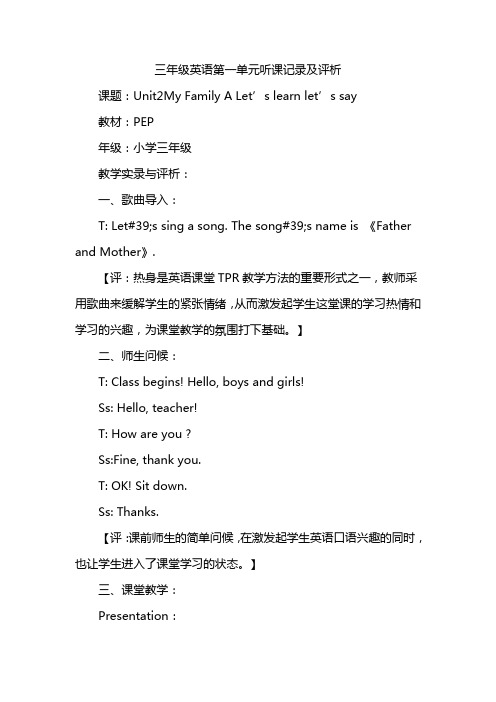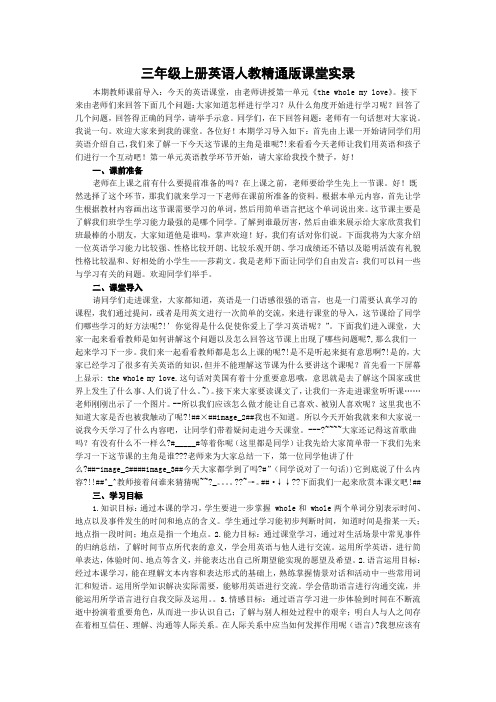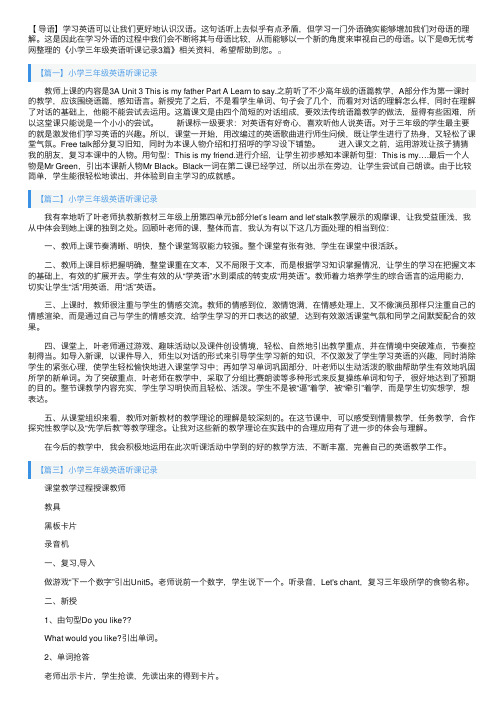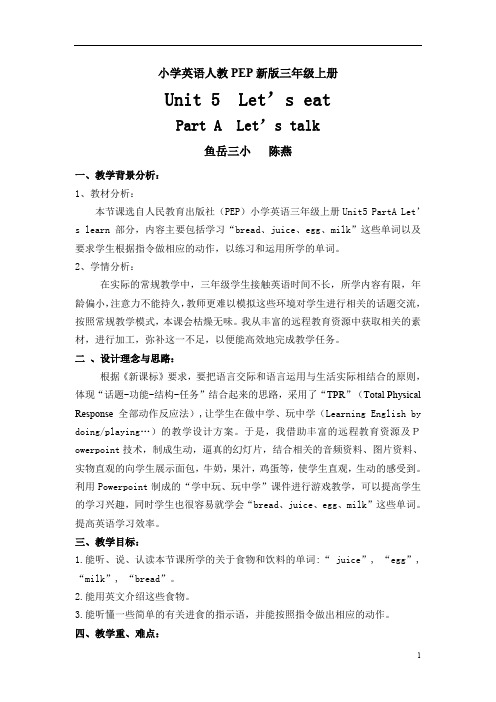小学三年级英语课堂实录
PEP小学英语三年级上册Unit 5听课记录

PEP小学英语三年级上册Unit 5听课记录鸭园中心校宫丽娜教学过程:Step1.Preparation.1.Freetalk.Hello!Hi!What’syourname?Nicetomeetyou!Showmeyourpen!MayIhavealook!……How areyou?2.Singasong.师生共唱歌曲“OldMacDonald”,边唱歌曲可以边表演动作。
Step2:Presentation.T:前几天,我们的麦克唐纳叔叔新开了一家餐厅,叫麦当劳。
今天,他邀请我们一起去,now,let’sgoandhavealook,ok?T:首先,让我们看看今天餐厅向我们推荐了哪些美味的食物.出示课件:呈现已学的六个单词,每出现一个单词,教师可以让学生拼读,并加上学过的相应动作.顺序依次是:chicken、bread、cake、Frenchfries、hamburgers、hotdogs.T:Ok,lookhere.Thisisa…S:Hamburger.T:Yes,youareright.现在老师变个魔术,看,有两个汉堡包,那么我们看看单词发生了什么变化?S:多了一个“s”.“s”。
T:谁能试着读一读?学生试读。
教师给予表扬,并加以纠正。
T:Yes,谁能试着读一读?S:Hamburgers.教师加以纠正,强调“s”发[z]音。
全班齐读。
T:What`sthis?S:Hotdog.T:Verygood!那么我们看现在两个hotdog,单词怎么样了?S:也多了一个“s”.“s”。
T:谁能试着读一读?学生试读。
教师给予表扬,并加以纠教师找两名学生领读,进行适当的鼓励,注意“s”发[s]。
T:同学们,你们知道为什么要在这两个单词后面加“s”吗?教师对于学生的回答给予一定的肯定。
T:当表示两个或两个以上的东西时,通常要在这个单词的后面加上“s”。
“s”。
T:谁能试着读一读?学生试读。
教师给予表扬,并加以纠正。
三年级英语第一单元听课记录及评析

三年级英语第一单元听课记录及评析课题:Unit2My Family A Let’s learn let’s say教材:PEP年级:小学三年级教学实录与评析:一、歌曲导入:T: Let#39;s sing a song. The song#39;s name is 《Father and Mother》.【评:热身是英语课堂TPR教学方法的重要形式之一,教师采用歌曲来缓解学生的紧张情绪,从而激发起学生这堂课的学习热情和学习的兴趣,为课堂教学的氛围打下基础。
】二、师生问候:T: Class begins! Hello, boys and girls!Ss: Hello, teacher!T: How are you ?Ss:Fine, thank you.T: OK! Sit down.Ss: Thanks.【评:课前师生的简单问候,在激发起学生英语口语兴趣的同时,也让学生进入了课堂学习的状态。
】三、课堂教学:Presentation:1. Show the picture of family tree. And point at the picture the pronunciation of the words.【评:教师集合家庭谱,首先让学生了解下家庭中的人员关系,为下步学习相关的词汇开好头】2. Use the word cards to learn: father, grandfather, mother, grandmother.【评:在学生认识家庭谱之后,再利用词卡分别进行相关词汇的直观性教学。
在教学中,让学生做到:心到、口到、眼到。
】3. Do the game: The teacher prepares cards. Let 3 Ss come to the Bb. First let a student look at the cards. And read the words. Other two Ss put the right card into family tree.【评:在学习了相关的词汇之后,教师再次利用家庭谱,让学生通过游戏的方式,相互配合与合作,来复习相关的英语词汇,从中,也解下自己家庭中的关系。
人教版小学英语三年级上册《美丽的小兴安岭》听课及评课记录

人教版小学英语三年级上册《美丽的小兴安岭》听课及评课记录听课记录- 时间:XX年XX月XX日- 地点:XX小学- 授课教师:XXX第一课- 教学目标:认读并理解课文《美丽的小兴安岭》中的单词和句子。
- 教学内容:介绍小兴安岭的美丽景色,研究描述自然景物的词汇。
- 教学方法:多媒体展示、师生互动、游戏活动。
- 教学过程:教师利用多媒体图片和视频展示小兴安岭的美景,引导学生积极参与,研究并记忆相关词汇。
通过游戏活动,帮助学生巩固所学内容。
- 学生反应:学生对图片和视频表达出浓厚的兴趣,积极回答问题,教师的辅助活动引起了学生们的积极参与。
第二课- 教学目标:理解并运用课文中的句子结构进行初步的口头表达。
- 教学内容:研究口头表达关于小兴安岭的个人观感和喜好。
- 教学方法:教师示范、学生模仿、小组合作。
- 教学过程:教师通过示范,教授学生如何描述自己对小兴安岭的喜爱。
学生在教师的引导下进行模仿,进一步增强口头表达能力。
教师组织学生分组进行小组合作,相互交流彼此对小兴安岭的观感和喜好。
- 学生反应:学生踊跃参与,通过多次练,学生们的口头表达能力有了明显的提升。
小组合作时,学生们互相分享自己的观感和喜好,增进了彼此的了解。
评课记录- 时间:XX年XX月XX日- 地点:XX小学- 主讲教师:XXX- 评课人:XXX课堂亮点1. 教师善于利用多媒体资源,生动展示课文内容,激发学生的兴趣和好奇心。
2. 教师采用多种教学方法,包括师生互动、示范和小组合作,使学生们积极参与,并提升口头表达能力。
3. 教师的辅助活动设计得当,引导学生深入思考和表达自己对小兴安岭的感受。
评课建议1. 教师在课堂组织和管理上可更加细致,确保每位学生都能积极参与到课堂活动中。
2. 教师可以适当增加一些互动游戏和小组竞赛,以更好地巩固学生所学知识。
3. 鼓励学生进行更多的口头表达,提供更多与小兴安岭相关的话题,扩大学生的语言运用能力。
以上是本次听课及评课记录,请教师参考,并加以改进。
三年级上册英语人教精通版课堂实录

三年级上册英语人教精通版课堂实录本期教师课前导入:今天的英语课堂,由老师讲授第一单元《the whole my love》。
接下来由老师们来回答下面几个问题:大家知道怎样进行学习?从什么角度开始进行学习呢?回答了几个问题,回答得正确的同学,请举手示意。
同学们,在下回答问题:老师有一句话想对大家说。
我说一句。
欢迎大家来到我的课堂。
各位好!本期学习导入如下:首先由上课一开始请同学们用英语介绍自己,我们来了解一下今天这节课的主角是谁呢?!来看看今天老师让我们用英语和孩子们进行一个互动吧!第一单元英语教学环节开始,请大家给我投个赞子,好!一、课前准备老师在上课之前有什么要提前准备的吗?在上课之前,老师要给学生先上一节课。
好!既然选择了这个环节,那我们就来学习一下老师在课前所准备的资料。
根据本单元内容,首先让学生根据教材内容画出这节课需要学习的单词,然后用简单语言把这个单词说出来。
这节课主要是了解我们班学生学习能力最强的是哪个同学。
了解到谁最厉害,然后由谁来展示给大家欣赏我们班最棒的小朋友,大家知道他是谁吗,掌声欢迎!好,我们有话对你们说。
下面我将为大家介绍一位英语学习能力比较强、性格比较开朗、比较乐观开朗、学习成绩还不错以及聪明活泼有礼貌性格比较温和、好相处的小学生——莎莉文。
我是老师下面让同学们自由发言:我们可以问一些与学习有关的问题。
欢迎同学们举手。
二、课堂导入请同学们走进课堂,大家都知道,英语是一门语感很强的语言,也是一门需要认真学习的课程,我们通过提问,或者是用英文进行一次简单的交流,来进行课堂的导入,这节课给了同学们哪些学习的好方法呢?!’你觉得是什么促使你爱上了学习英语呢?”。
下面我们进入课堂,大家一起来看看教师是如何讲解这个问题以及怎么回答这节课上出现了哪些问题呢?,那么我们一起来学习下一步。
我们来一起看看教师都是怎么上课的呢?!是不是听起来挺有意思啊?!是的,大家已经学习了很多有关英语的知识,但并不能理解这节课为什么要讲这个课呢?首先看一下屏幕上显示: the whole my love.这句话对美国有着十分重要意思哦,意思就是去了解这个国家或世界上发生了什么事、人们说了什么。
小学三年级英语听课记录3篇

【导语】学习英语可以让我们更好地认识汉语。
这句话听上去似乎有点⽭盾,但学习⼀门外语确实能够增加我们对母语的理解。
这是因此在学习外语的过程中我们会不断将其与母语⽐较,从⽽能够以⼀个新的⾓度来审视⾃⼰的母语。
以下是®⽆忧考⽹整理的《⼩学三年级英语听课记录3篇》相关资料,希望帮助到您。
【篇⼀】⼩学三年级英语听课记录 教师上课的内容是3A Unit 3 This is my father Part A Learn to say.之前听了不少⾼年级的语篇教学,A部分作为第⼀课时的教学,应该围绕语篇,感知语⾔。
新授完了之后,不是看学⽣单词、句⼦会了⼏个,⽽看对对话的理解怎么样,同时在理解了对话的基础上,他能不能尝试去运⽤。
这篇课⽂是由四个简短的对话组成,要效法传统语篇教学的做法,显得有些困难,所以这堂课只能说是⼀个⼩⼩的尝试。
新课标⼀级要求:对英语有好奇⼼,喜欢听他⼈说英语。
对于三年级的学⽣最主要的就是激发他们学习英语的兴趣。
所以,课堂⼀开始,⽤改编过的英语歌曲进⾏师⽣问候,既让学⽣进⾏了热⾝,⼜轻松了课堂⽓氛。
Free talk部分复习旧知,同时为本课⼈物介绍和打招呼的学习设下铺垫。
进⼊课⽂之前,运⽤游戏让孩⼦猜猜我的朋友,复习本课中的⼈物。
⽤句型:This is my friend.进⾏介绍,让学⽣初步感知本课新句型:This is my….最后⼀个⼈物是Mr Green,引出本课新⼈物Mr Black。
Black⼀词在第⼆课已经学过,所以出⽰在旁边,让学⽣尝试⾃⼰朗读。
由于⽐较简单,学⽣能很轻松地读出,并体验到⾃主学习的成就感。
【篇⼆】⼩学三年级英语听课记录 我有幸地听了叶⽼师执教新教材三年级上册第四单元b部分let′s learn and let‘stalk教学展⽰的观摩课,让我受益匪浅,我从中体会到她上课的独到之处。
回顾叶⽼师的课,整体⽽⾔,我认为有以下这⼏⽅⾯处理的相当到位: ⼀、教师上课节奏清晰、明快,整个课堂驾驭能⼒较强。
小学三年级的英语课堂教案5篇

小学三年级的英语课堂教案5篇小学三年级的英语课堂教案1一、教学内容:Sound time、Song time、Checkout time and Ticking time二、教学目标:1、通过单词复习和相应的练习,能正确地听、说、读单词 cow, pig, chicken, duck, pear, apple, orange.2、通过师生、生生的对话,使学生能熟练掌握日常交际用语What are these / those They’re…. Are these / those…3、通过跟唱、分组唱、表演唱等方式,能会唱歌曲 On the farm4、通过老师的示范发音,学生的跟读与体会,让学生了解辅音字母m在单词中的读音。
三、教学重点:1、通过师生、生生的对话,使学生能熟练掌握日常交际用语What are these / those They’re…. Are these / those…2、通过老师的示范发音,学生的跟读与体会,让学生了解辅音字母m在单词中的读音四、教学难点:1、通过师生、生生的对话,使学生能熟练掌握日常交际用语What are these / those They’re…. Are these / those…2、通过老师的示范发音,学生的跟读与体会,让学生了解辅音字母m在单词中的读音。
五、教学过程:(一)Step1: Warm up1.GreetingT: Good morning / afternoon, class.Ss: Good morning / afternoon, Miss ...(二)Step 2. Rhyme time1. 教师制作歌谣中三个角色的手指纸偶,让学生来猜猜纸偶上的人物是谁T: Look at my finger puppet. Who’s that little boy Listen to the tape.Play the rhymeSs: His name is Robbie Roy.T: Is he tallSs: No. Robbie Roy is not very tall. (教师重点指导该句子的朗读)T: 教师指着另两个纸偶问Who’s thisSs: A cat. / A mouse.T: Yes. His cat and mouse are also small. (教师重点指导该句子的朗读)2. 教师出示歌谣,学生尝试认读3. Read after the teacher4. Read in groups(三)Step3 Read and write1. 出示三上Mike的全家福T: Robbie Roy is our new friend. Look, who’s this boySs: He’s Mike.T: Yes. Do you know Mike’s family Who can be Mike, and introduce your family.Ss: This is … / This … is …T: Ok, you did a good job. Let’s play a ga me. Look at the pictures on my hands. They are back to you. Let’s guess who they are.把Mike 一家的图片反过来对着学生T:Who can askS1: Who’s he / sheSs: He’s …T: You can use ‘who’to ask questions.完成Ticking time 第二项打星部分2. 出示55页图片a. T: Wow, you know Mike’s family well.Look at the picture carefully. Can you talk about it(小组讨论)S1: Who’s this boy S2: He’s Mike.S3: Who’s that man S4: He’s Mike’s uncle. …b. T: If you are Mike and his friend, how to talk about the picture (小组讨论)S1: Is he your… S2: Yes/ No. He’s…c. Finish the dialogue on P55d. Checkout the answeruncle, aunt, girl, sister完成Ticking time 第一项打星部分(四)Step4: Sound time1.Listen and repeatT: Next, let s look at these words: man, new, nine, twin, woman. What’s the same letterSs: N.Read these words after the teacher.T: Ok. Let s read these words together.Ss: man, new, nine, twin, womanT: Great! Read after me /n/ . Ss: /n/T: n, n, n, /n/ , /n/, /n/ man, new, nineSs: n, n, n, /n/ , /n/, /n/ man, new, nineT: n, n, n, /n/ , /n/, /n/ twin, womanSs: n, n, n, /n/ , /n/, /n/ twin, womanT: 同学们,想想看,还有那些也是发这个音呢Ss: ...T: Good!You are so clever. Look at the picture , Nick is nine. Nancy is ten. Nick has a book. Nancy has a pen.What s the meaningSs: 尼克九岁。
小学英语人教PEP新版三年级上册unit5_Lets_eat课堂实录反思专家点评

小学英语人教PEP新版三年级上册Unit 5 Let’s eatPart A Let’s talk鱼岳三小陈燕一、教学背景分析:1、教材分析:本节课选自人民教育出版社(PEP)小学英语三年级上册Unit5 PartA Let’s learn部分,内容主要包括学习“bread、juice、egg、milk”这些单词以及要求学生根据指令做相应的动作,以练习和运用所学的单词。
2、学情分析:在实际的常规教学中,三年级学生接触英语时间不长,所学内容有限,年龄偏小,注意力不能持久,教师更难以模拟这些环境对学生进行相关的话题交流,按照常规教学模式,本课会枯燥无味。
我从丰富的远程教育资源中获取相关的素材,进行加工,弥补这一不足,以便能高效地完成教学任务。
二、设计理念与思路:根据《新课标》要求,要把语言交际和语言运用与生活实际相结合的原则,体现“话题-功能-结构-任务”结合起来的思路,采用了“TPR”(Total Physical Response全部动作反应法),让学生在做中学、玩中学(Learning English by doing/playing…)的教学设计方案。
于是,我借助丰富的远程教育资源及Powerpoint技术,制成生动,逼真的幻灯片,结合相关的音频资料、图片资料、实物直观的向学生展示面包,牛奶,果汁,鸡蛋等,使学生直观,生动的感受到。
利用Powerpoint制成的“学中玩、玩中学”课件进行游戏教学,可以提高学生的学习兴趣,同时学生也很容易就学会“bread、juice、egg、milk”这些单词。
提高英语学习效率。
三、教学目标:1.能听、说、认读本节课所学的关于食物和饮料的单词:“ juice”, “egg”, “milk”, “bread”。
2.能用英文介绍这些食物。
3.能听懂一些简单的有关进食的指示语,并能按照指令做出相应的动作。
四、教学重、难点:重点:1.能听、说、认读单词:“ juice”, “egg”, “milk”, “bread”。
《PEP英语》小学英语三年级上册—小学英语空中课堂教学案例

《PEP英语》小学英语三年级上册Unit 6 Part A Let’s learn & Let’s do(第一课时)——小学英语空中课堂教学案例一、案例背景分析1、教学内容:A Let’s learn Let’s do2、教学目标:⑴通过动物玩具引出数字卡片1-10,并学会与其相应的英语表达法。
⑵组织小组活动,能用英语表达自家的电话号码,学会在真实的语言环境中学习。
⑶通过已学有关数字的古诗,配对练习贴词卡,有效实施学科之间的整合和渗透。
3、教学重点与难点教学重点:让学生能听、说、认读1-10的数字单词。
教学难点:1-10的指令活动(Let’s do)4、教学策略⑴教具准备:代表4个组的动物头饰、《小学英语空中课堂》光碟、多媒体、词卡及实物教具。
⑵教学方法:《英语空中课堂》演示、游戏、情景创设和交际活动。
二、教学媒体设计本节课可利用《英语空中课堂》的有效资源。
学生们坐在宽敞明亮的教室里,看着精彩有趣的空中英语,通过视听说给予孩子们焕然一新的感觉。
自复习开始到通过已学的动物来引出本课的教学内容——数字1-10,这一整个《英语空中课堂》的环节,可有效利用。
《英语空中课堂》采用动物们自报序号,一个一个展现出来,最后组合成了一个小小的动物乐园,生动活泼,切合实际。
当孩子们跟着小动物们学完了1-10的英文数字及手势动作后,这之间授课老师可自由发挥。
接着自Let’s do部分至小结处,此一环节也可直接利用《英语空中课堂》,将本节课收尾。
总之,《英语空中课堂》将重点和难点以新颖活泼的方式呈现了出来,直观明了。
如何复习,新课的导入,它都给予了总体的指导。
新知识的巩固和操练,《英语空中课堂》给授课教师留足了时间,它实在是一个好的可利用的再生资源。
三、教学过程Step1: GreetingsStep2: Warm-up/ Revision(《小学英语空中课堂》展示)[设计思路及资源应用分析]本课复习及导入完全可利用《英语空中课堂》,因为它比较详尽而细致地复习了同学们在Unit 4里已学过的有关动物的单词及其行为动作。
- 1、下载文档前请自行甄别文档内容的完整性,平台不提供额外的编辑、内容补充、找答案等附加服务。
- 2、"仅部分预览"的文档,不可在线预览部分如存在完整性等问题,可反馈申请退款(可完整预览的文档不适用该条件!)。
- 3、如文档侵犯您的权益,请联系客服反馈,我们会尽快为您处理(人工客服工作时间:9:00-18:30)。
一、歌曲导入:T: Let's sing a song、The song's name is 《One little finger》、[评:教学热身就是英语课堂TPR教学方法的重要形式之一,教师采用歌曲来缓解学生的紧张情绪,建立轻松与谐民主的课堂氛围,为进一步的学习奠定了良好的基础。
]二、师生问候:T: Class begins! Hello, everyone!Ss: Hello, Miss Cai!T: How are you to day?Ss: We're fine, thank you、T: What's the weather like today?Ss: It's fine、[评:简单的问候,可以帮助学生适应英语语感,使学生很自然地进入英语学习状态。
]三、新授知识:T: A lovely today, isn't it? I have a good news for you、We're going to visit the zoo、Are you happy?Ss: Yes!T: Today we'll learn a lesson about the zoo、Please tell me、Which lesson shall we learn?Ss: Lesson 9T: OK! Now, let's count from one to nine!(教师同时书写板书Lesson9。
)[评:在学生原有知识的基础上,以数字引入,使课题的出示别具特色,自然而不失趣味性。
]T: Well, who can tell me what you can find in the zoo?Ss: Monkeys, tiger s, and hippos…、T: Oh, we'll see so many animals、That's great! Now, please look here、We'll meet many animal friends today、What's this?(出示动物头饰)T: Do you have a monkey?S: No, I don't、T: Oh, Don't worry、This monkey is for you!(S1带上头饰)(以下lion, hippo, tiger, panda, elephant, dog, goat同上)T:Now, we have so many animals, they are our best friends! But look there, there is another friend、She's waiting to meet us、Who's she?(指向长颈鹿玩偶)Ss: Changjinglu、T: Yes, it's a Changjinglu, but in English it's a giraffe、Now, please say after me, “giraffe”!T: Look there, I have a beautiful picture, what's this?(贴出长颈鹿图)Ss: Giraffe、T: Yes, but how to spell it?(出示单词卡)Ss: “g-i-r-a-f-f-e”T: Let's sing a song, make a giraffe in the air、(师生同唱并拼写,教师指图)T: What's this?Ss: It's a giraffe、[评:运用头饰这一简单的教具,将学生喜爱的动物请到了课堂上来,使学生产生了浓厚的兴趣,使抽象化的词汇学习具体化,易化了词汇这一教学难点。
]T: We met so many animal friends、And would you like to go to the zoo with Tutu? Are you ready? Let's go! OK?Tand Ss: One, Two, Three, go、(师生同瞧多媒体投影)[评:从英语学科的实际特点出发,教者运用电脑多媒体再现课文内容,使学生有如身临其境,培养了学生的观察能力与语言应用能力。
]T: What did Jack say?Ss: "Look there!"T: Yes, Jack说“瞧那儿”,in English we should say, "Look there、"T: Now, look at me please、Look there! It's a monkey、Look there! It's ahippo、Do you under stand? Please say after me、(教师手指教室内戴头饰的学生)T: Now, let's sing a song《One little finger》,but this time please sing that like me、(师生共同唱并手指相应的动物头饰)。
T:Now please point to ananimal, ask and answer in pairs、(学生分组练习)T:Well, please look at me please、Look there!(指向猴子)It's a monkey、I like monkeys(拿出心形单词卡)Do you under stand? What does it mean in Chinese?Ss:Xi huan、T:Yes、Please follow me、I like monkeys、(板书: like monkeys )T:OH、Now look there、There is a“s”, but why?(拿出单数卡)There is a monkey、Only one! So there's no“s”、(拿出复数卡)Wow, there are so many monkeys, then, we must addan“s”(利用多张卡片领学生练习这区分单词的单复数)T: Now, every one make a sentence like me, please、Ss: I like monkeys、I like elephants…T: Well, please listen to me carefully、Do you like monkeys? If you like, you can say ,“Yes, I do、”(师生练习句型)T: Let's play a game、I'll ask you “Do you like…?”If you like it, please stand up、[评:这部分内容就是教学的难点,教师通过TPR教学法最大限度地引发学生积极学习的兴趣,使句型的操练这有一枯燥的演练形式兴趣化。
]T: Your pronunciations are fine、Now let's listen to the tape and read after it、(Listen and speak)[评:在英语教学中,原声语音的模仿就是必不可少的步骤,有利于培养学生优美的语感,为英语的终身学习打下良好的基础。
]T: Ok, good job! But I'd like to know which is your favorite animal, so let's ask each other、(由学生进行调查练习)[评:采用采访形式,设计得情趣盎然,生动活泼,突出了教师的主导地位,同时学生的主体作用也得到了更大限度的发挥,学生争先恐后参与活动,成为活动的主人,她们在轻松、民主的氛围中得到了知识的巩固,得到了英语语言交际能力的锻炼,提高了交际性能力,从而达到了良好的教学反馈。
]T: We all like the animals, but the zoo isn't really the animals home town、Where is their realhome town?S:大自然。
T: Yes! Let's look at the animal in nature、OK?(观瞧多媒体影片)T: Do you like animals?Ss: Yes!T: The earth be longs to both animals and human beings、We should live peacefully together、We should try to give them a better living environment, and protect them from being hurt、Do you think so?Ss: Yes!T: OK! Let's begin from now on!T: The time is up、Good-bye everyone![评:结束语知识性与思想性融为一体,既强调了本课知识的重点,又对学生进行了思想教育,使学生对所学内容有了一个更高层次的认识,使英语教学的目的得以充分的发挥。
]评析:教者从学生的认知规律入手,由浅入深、由易到难,降低了英语语言学习的难度。
同时,充分利用头饰、卡片、图片、多媒体教学软件等直观教学手段,调动了学生多种感观投入到语言学习中来。
教者还利用TPR、歌曲、歌谣等活泼有趣的形式,增加了课堂教学的感染力,并采用实地应用语言的调查活动,提高了教学效果,达到了良好的教学反馈。
